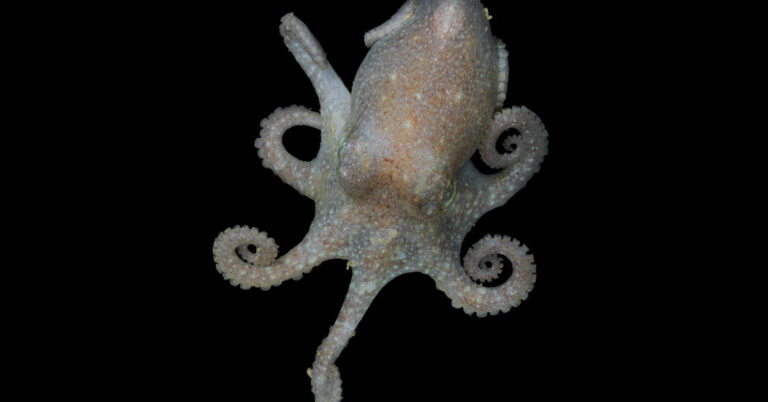Scientists have long wondered whether the West Antarctic Ice Sheet is a ticking time bomb in terms of sea level rise. New evidence from the DNA of a small octopus living in the Southern Ocean suggests that the ice sheet is indeed at risk of collapse, according to a study published Thursday in the journal Science.
The research does not predict when this might happen, but it suggests that 1.5 degrees Celsius of global warming over the preindustrial global average, or perhaps even less than that, could be a tipping point for the ice sheet. The Earth is close to that temperature level now.
Several unique populations of Pareledone turqueti, commonly known as Turquet’s octopus, live in the waters around Antarctica today. These octopuses crawl on the sea floor and generally do not stray far from home. Some individuals or their eggs may occasionally drift with currents to neighboring groups, but populations in the Ross Sea and Weddell Sea are separated by the impassable West Antarctic Ice Sheet.
However, genetic analysis of octopuses from different locations around Antarctica shows that these two populations were mixing and exchanging DNA about 120,000 years ago. This was a period in Earth’s history called the Last Interglacial period, before the last ice age, when temperatures were similar to today.
The observed patterns in the octopus gene pool would only be possible if the West Antarctic ice sheet was not there at the time and relatively open seas across the continent allowed octopuses to travel freely between the Ross and Weddell Seas, according to to researchers.
Scientists know how many meters the sea level was then. But whether the additional water came from West Antarctica is “the question the geoscience community has been trying to answer for almost 50 years,” said Sally Lau, a postdoctoral researcher at James Cook University in Townsville, Australia, and lead author of the new study author.
Today, the global average temperature is about 1.2 degrees Celsius higher than in 1850 to 1900, when the burning of fossil fuels began to warm the climate. During the Last Interglacial, average global temperatures were about 0.5 to 1.5 degrees Celsius warmer than the preindustrial base line, but sea levels were five to 10 meters higher than today. If climate change completely melts the West Antarctic ice sheet, sea levels could rise by an average of up to five meters, or 16 feet. (The East Antarctic Ice Sheet holds more frozen water, but it is considered more stable.)
The researchers did not say outright whether today’s temperatures have already committed the planet to a complete collapse of the western ice sheet. “We still can’t say for sure, but that’s the definite implication,” said Nicholas Golledge, a professor of glaciology at Victoria University of Wellington in New Zealand and another author of the study.
If the ice sheet reaches its tipping point, estimates of how quickly it will melt are anywhere from 200 years to 2,000 years. “Our actions from this point forward will still change the rate at which we get there,” said Dr. Golledge.
Unlike today, the Last Interglacial was part of an ongoing natural cycle of changes in the tilt of Earth’s axis and its orbit around the sun, and the resulting changes in the amount of sunlight the planet received. These cycles occur gradually over tens of thousands of years. Our current greenhouse gas emissions are causing similar changes in temperature, but at a much faster rate.
Although the reasons behind past and present warming are different, the Last Interglacial is still one of the best analogues for current climate change, said Roger Creel, a postdoctoral scholar at the Woods Hole Oceanographic Institution. He was not involved in the study published Thursday but contributed to estimates of sea level at that time.
“This is very strong evidence from a completely different vantage point than the climate community often holds,” said Dr. Creel about the new study.
Some of the octopus specimens studied by Dr. Lau was collected more than 30 years ago, from fishing boats and scientific expeditions, and held in museums. Because DNA in dead animals degrades over time, this type of research using museum specimens has not been possible until recently with advances in genetic sequencing.
Other scientists have shown that the genetics of land animal populations is consistent with past melting of the West Antarctic Ice Sheet. A 2020 springtails studysmall land-dwelling invertebrates, also suggested that ice in the Ross Sea region melted during warm periods over the past 5 million years, including during the Last Interglacial.
Geoscientists can use mathematical models to reconstruct ice sheets and sea levels in the past, but emerging biological evidence will help validate these changes, said Ian Hogg, a research scientist at Polar Knowledge Canada, an agency that monitors the polar regions, and an author of the springtails study.
“As biologists, we know that these patterns exist in populations,” he said. The challenge for biologists is explaining these observed patterns, while a challenge for geoscientists studying Antarctica is gathering enough observational, physical evidence to validate their models.
“They have something they’re giving us,” said Dr. Hogg. “And we have something we can give them.”
